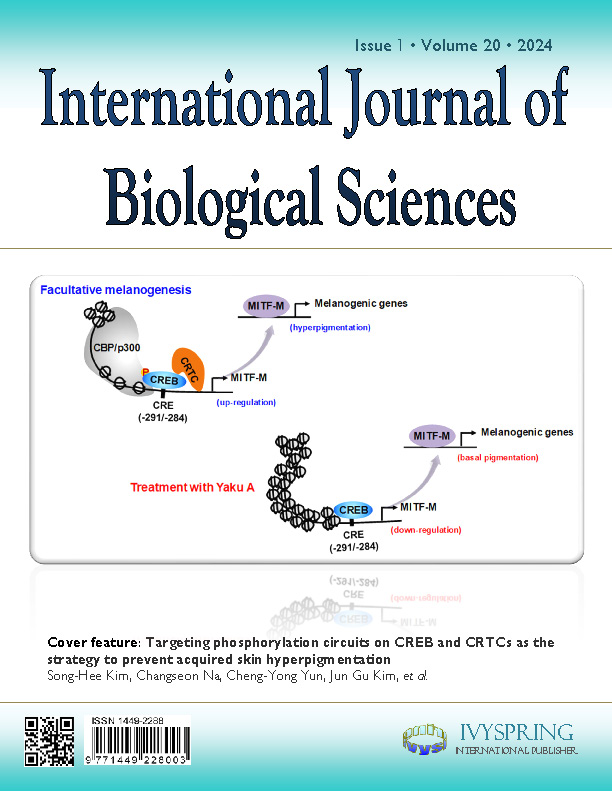ESM1 facilitates the EGFR/HER3-triggered epithelial-to-mesenchymal transition and progression of gastric cancer via modulating interplay between Akt and angiopoietin-2 signaling
IF 10
2区 生物学
Q1 BIOCHEMISTRY & MOLECULAR BIOLOGY
引用次数: 0
Abstract
Gastric cancer (GC) poses global challenges due to its difficult early diagnosis and drug resistance, necessitating the identification of early detection markers and understanding of oncogenic pathways for effective GC therapy. Endothelial cell-specific molecule 1 (ESM1), a secreted glycoprotein, is elevated in various cancers, but its role in GC remains controversial. In our study, ESM1 was elevated in GC tissues, and its concentration was correlated with progression and poorer patient prognosis in independent cohorts. Functionally, ESM1 expression promoted proliferation, anoikis resistance, and motility of GC cells, as well as tumor growth in PDOs and in GC xenograft models. Mechanistically, ESM1 expression triggered the epithelial-to-mesenchymal transition (EMT) of GC cells by enhancing epidermal growth factor receptor (EGFR)/human EGFR 3 (HER3) association and activating the EGFR/HER3-Akt pathway. Additionally, angiopoietin-2 (ANGPT2) was found to be highly correlated with ESM1 and interplayed with Akt to induce the EMT and cancer progression. Use of a signal peptide deletion mutant (ESM1-19del) showed that the secreted form of ESM1 is crucial for its protumorigenic effects by activating the EGFR/HER3-Akt/ANGPT2 pathway to promote the EMT. Patients with high levels of both ESM1 and ANGPT2 had the poorest prognoses. Furthermore, therapeutic peptides successfully inhibited ESM1's induction of the aforementioned signals and motility of GC cells. ESM1's oncogenic role in GC involves activating the EGFR/HER3-Akt/ANGPT2 pathway, presenting a potential therapeutic target for GC.ESM1通过调节Akt和血管生成素-2信号之间的相互作用,促进表皮生长因子受体(EGFR)/表皮生长因子受体(HER3)触发的上皮细胞向间质转化和胃癌的进展
胃癌(GC)因其难以早期诊断和耐药性而构成全球性挑战,因此有必要确定早期检测标志物并了解致癌途径,以便对胃癌进行有效治疗。内皮细胞特异性分子 1(ESM1)是一种分泌性糖蛋白,在多种癌症中都会升高,但它在 GC 中的作用仍存在争议。在我们的研究中,ESM1在GC组织中升高,在独立队列中,其浓度与疾病进展和较差的患者预后相关。在功能上,ESM1的表达促进了GC细胞的增殖、耐嗜酸性和运动性,并促进了PDOs和GC异种移植模型中的肿瘤生长。从机理上讲,ESM1的表达通过增强表皮生长因子受体(表皮生长因子受体)/人表皮生长因子受体3(HER3)的结合和激活表皮生长因子受体/HER3-Akt通路,触发了GC细胞的上皮细胞向间质转化(EMT)。此外,研究还发现血管生成素-2(ANGPT2)与 ESM1 高度相关,并与 Akt 相互作用,诱导 EMT 和癌症进展。信号肽缺失突变体(ESM1-19del)的使用表明,ESM1的分泌形式对于其通过激活表皮生长因子受体/HER3-Akt/ANGPT2通路促进表皮生长因子受体转化(EMT)的原癌基因效应至关重要。ESM1和ANGPT2水平都很高的患者预后最差。此外,治疗肽成功地抑制了ESM1对上述信号的诱导和GC细胞的运动。ESM1在GC中的致癌作用包括激活表皮生长因子受体/HER3-Akt/ANGPT2通路,为GC提供了一个潜在的治疗靶点。
本文章由计算机程序翻译,如有差异,请以英文原文为准。
求助全文
约1分钟内获得全文
求助全文
来源期刊

International Journal of Biological Sciences
生物-生化与分子生物学
CiteScore
16.90
自引率
1.10%
发文量
413
审稿时长
1 months
期刊介绍:
The International Journal of Biological Sciences is a peer-reviewed, open-access scientific journal published by Ivyspring International Publisher. It dedicates itself to publishing original articles, reviews, and short research communications across all domains of biological sciences.
 求助内容:
求助内容: 应助结果提醒方式:
应助结果提醒方式:


